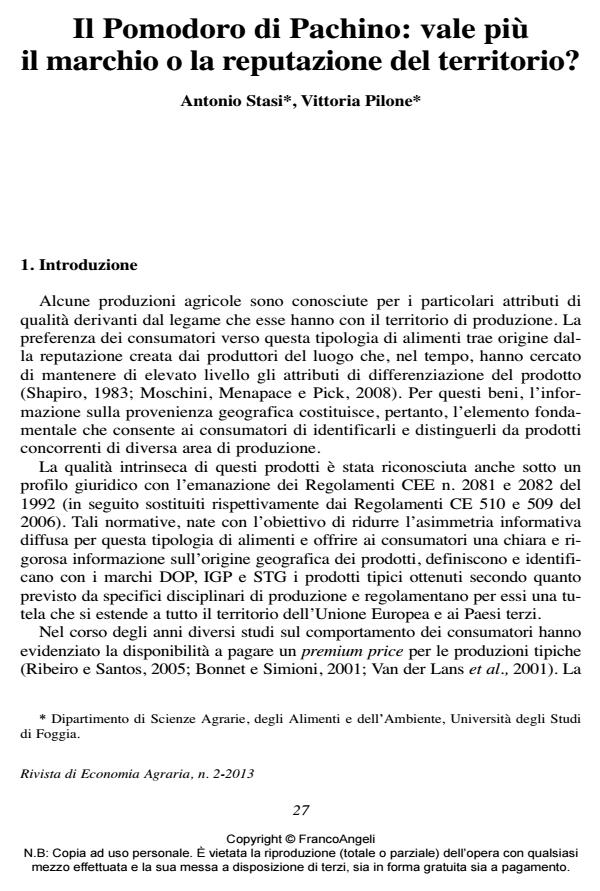Il Pomodoro di Pachino: vale più il marchio o la reputazione del territorio?
Titolo Rivista RIVISTA DI ECONOMIA AGRARIA
Autori/Curatori Antonio Stasi, Vittoria Pilone
Anno di pubblicazione 2014 Fascicolo 2013/2 Lingua Italiano
Numero pagine 16 P. 27-42 Dimensione file 705 KB
DOI 10.3280/REA2013-002002
Il DOI è il codice a barre della proprietà intellettuale: per saperne di più
clicca qui
Qui sotto puoi vedere in anteprima la prima pagina di questo articolo.
Se questo articolo ti interessa, lo puoi acquistare (e scaricare in formato pdf) seguendo le facili indicazioni per acquistare il download credit. Acquista Download Credits per scaricare questo Articolo in formato PDF

FrancoAngeli è membro della Publishers International Linking Association, Inc (PILA)associazione indipendente e non profit per facilitare (attraverso i servizi tecnologici implementati da CrossRef.org) l’accesso degli studiosi ai contenuti digitali nelle pubblicazioni professionali e scientifiche
Geographical Indications certify the link between quality of some agro-food productions and their territory. For these products the premium price is derived from both certification and reputational effect of the territory, since there are products without Geographical Indication that have a rent associated with the area of production. With the case study proposed in this paper the separate effect of these two factors is measured. The analysis is focused on "tomato from Pachino" with brand of protected geographical indication (PGI). The survey is conducted over a random sample of 700 consumers living in Italy. Results shows that consumers pay a higher price for "tomato from Pachino PGI" than price paid for product with only indication of area of production. Neverthelerss, a lack of knowledge about the meaning of PGI brand is observed. The analysis is completed by segmenting the market, allowing the identification of consumers more likely to buy certified product.;
Keywords:Marchio di tipicità, choice model, pomodoro di Pachino, comportamento dei consumatori
Jel codes: Q13, Q18, L15
- Bonnet C., Simioni M. (2001). Assessing Consumer Response to Protected Designation of Origin Labelling: a Mixed Multinomial Logit Approach. European Review of Agricultural Economics, 28(4), DOI: 10.1093/erae/28.4.433
- Burton M., Rigby D., Young T., James S. (2001). Consumer attitudes to genetically modified organism in food in the U.K. European Review of Agricultural Economics, 28(4): 479-498, DOI: 10.1093/erae/28.4.479
- Cicia G., Del Giudice T., Ramunno I. (2009). Environmental and health components in consumer perception of organic products: estimation of willingness to pay. Journal of food products marketing, 15(3): 324-336, DOI: 10.1080/10454440902925930
- Cicia G., Del Giudice T., Scarpa R. (2004). Consumers’ Perception of Quality in Organic Food: a Random Utility Model under Preference Heterogeneity and Choice Correlation from Rank-orderings. British Food Journal, 104 (3, 4, 5).
- Díaz F.J.M., Pleite F.M.C., Paz J.M.M., García P.G. (2012). Consumer knowledge, consumption, and willingness to pay for organic tomatoes. British Food Journal, 114(3): 318-334, DOI: 10.1108/00070701211213447
- Lopez R.A., Pagoulatos E., Gonzalez M.A. (2006). Home bias and US imports of processed food products. The North American Journal of Economics and Finance, 17(3): 363-373, DOI: 10.1016/j.najef.2006.06.003
- McFadden D. (1974). Conditional logit analysis of qualitative choice behaviour. In Zarembka P. (ed). Frontiers in Econometrics. New York: Academic Press, pp. 105-142.
- Moschini G., Menapace L., Pick D. (2008). Geographical Indications and the competitive provision of quality in agricultural markets. American Journal of Agricultural Economics, DOI: 10.1111/j.1467-8276.2008.01142.x
- Onozaka Y., McFadden D.T. (2011). Does Local Labeling Complement or Compete with Other Sustainable Labels? A Conjoint Analysis of Direct and Joint Values for Fresh Produce Claim. American Journal of Agricultural Economics, 93(3): 693-706, DOI: 10.1093/ajae/aar005
- Ribeiro J., Santos J. (2005). Portuguese olive oil and the price of regional products: does designation of origin really matter? Tékhne – Polytechnical Studies Review, 2(3): 61-76.
- Roselli L., Seccia A., Stasi A. (2006). Atteggiamento dei consumatori nei confronti dell’evoluzione del sistema agro-alimentare: l’introduzione di alimenti geneticamente modificati. Economia agro-alimentare, (1): 127-150.
- Shapiro C. (1983). Premiums for High Quality Products as Returns to Reputations. The Quarterly Journal of Economics, 98(4): 659-79, DOI: 10.2307/1881782
- Van der Lans I., van Ittersum K., De Cicco A., Loseby M. (2001). The Role of the Region of Origin and EU Certificates of Origin in Consumer Evaluation of Food Products. European Review of Agricultural Economics, 28(4), DOI: 10.1099/erae/28.4.451
- Yue C., Tong C. (2009). Organic or Local? Investigating Consumer Preference for Fresh Produce Using a Choice Experiment with Real Economic Incentives. Hortscience, 44(2): 366-371.
Antonio Stasi, Vittoria Pilone, Il Pomodoro di Pachino: vale più il marchio o la reputazione del territorio? in "RIVISTA DI ECONOMIA AGRARIA" 2/2013, pp 27-42, DOI: 10.3280/REA2013-002002